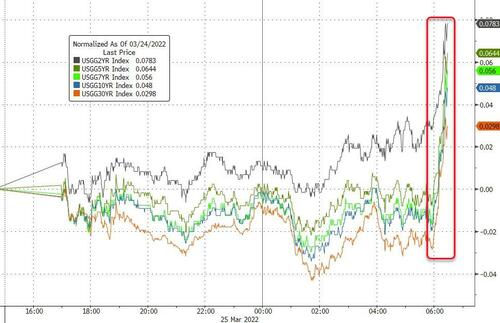Treasury Yields Spike After Citi Calls For 4 Straight 50bps Hikes This Year
Treasury yields are soaring higher this morning, seemingly triggered by a hawkish note by Citi economists calling for an even more aggressive Fed this year than the market is pricing for.
In a note published by Citigroup’ Andrew Hollenhorst the bank said that it now sees 2.75% of hikes – including four straight half-point moves – amid persistent inflation.In addition, “we expect the Fed to continue hiking into 2023” and sending the benchmark rate to a range of 3.5% to 3.75%, analysts led by Andrew Hollenhorst said in a research note Friday.
More from the note:
We are revising our “base case” for Fed policy rates from 200bp of rate hikes in 2022 to 275bp in rate hikes in 2022. Rather than one 50bp rate hike in May (our previous base case) we now expect the Fed to raise rates in 50bp increments in May, June, July and September followed by 25bp hikes in October and December.
While we had viewed risks around our Fed policy rate forecasts as skewed heavily to the upside, we see more balanced risk around our updated modal scenario. Should inflation moderate more than we expect or broader financial conditions tighten abruptly (e.g. a 20%+ equity market sell-off), officials might return to 25bp hikes in July meaning a total of 225bp of rate hikes. On the other hand, continued 5%+ annualized inflation could lead to 50bp hikes at every remaining meeting, delivering 325bp of cumulative rate increase.
Recent Fed speak raised our conviction that Chair Powell and the broader committee will support a 50bp rate hike in May (despite balance sheet reduction announced at the same meeting). It appears that 50bp would have been delivered in March if not for acute uncertainty related to geopolitical tensions. With inflation likely to be very strong in March (headline 1%+MoM thanks to higher gasoline prices and core continuing to rise ~0.5%MoM) and to remain elevated in April, we think it will be hard for Fed officials to argue why they would not raise rates 50bp again in June.
Continued 50bp hikes in July and September will materialize if inflation stays above 2% on a monthly annualized basis and broadly across categories. Again, it will be difficult for Fed officials to explain (either internally to build consensus or externally to the public) why rate hikes should slow so long as policy rates are below 2.5% (the Fed’s estimate of long-term neutral) and inflation is not meaningfully slowing.
As we laid out yesterday, Fed dots may come much of the way toward our base case by the June FOMC meeting if two 50bp hikes have been delivered in May and June and a significant group of Fed officials want to continue at a 50bp pace until 2% is reached.
It’s important to keep in mind that there is nothing special about 50bp increments. If inflation unexpectedly accelerates or long-term inflation expectations rise rapidly (e.g. University of Michigan 5-10y above 3.5%) it is possible the Fed would hike by more than 50bp (e.g. by 75bp) at a meeting.
With so much attention on the path of rate hikes, market attention has been taken off the balance sheet to some extent. We continue to expect an announcement of balance sheet reduction in May. Minutes from the March meeting (out April 6) are likely to give some information on the size of “caps” on reinvestments and other details related to balance sheet reduction.
In comments yesterday, Chicago Fed President Evans suggested that maturities might be reinvested in T-bills to bring the balance sheet down faster – a strategy we highlighted as an option. One reason Fed officials have been confident the balance sheet can fall faster is the potential to rapidly drain over $1.5trln in the reverse repo facility (RRP). However, enhanced demand for safe, short-maturity paper and a more rapid rise in money fund rates that will not be matched by bank deposit rates has raised our concern that RRP cash will be sticky and bank reserves instead will be drained – a potential more economically meaningful reduction in liquidity.
The short-end – as one would expect – is getting hit hardest but the entire curve is bear flattening (2Y +10bps, 30Y +4bps)
Meanwhile, as rate-hike expectations surge (market now pricing in more than 8 further 25bps hikes this year), the subsequent rate-cut expectations are also rising for 2023/4…
Crypto is rallying here as gold fades and stocks tumble at the cash open.
Tyler Durden
Fri, 03/25/2022 – 09:36

